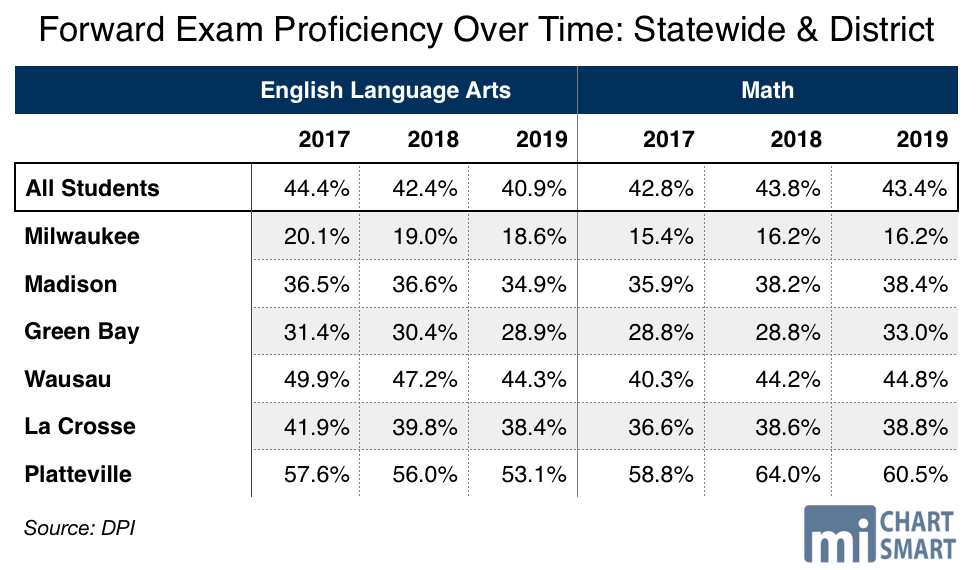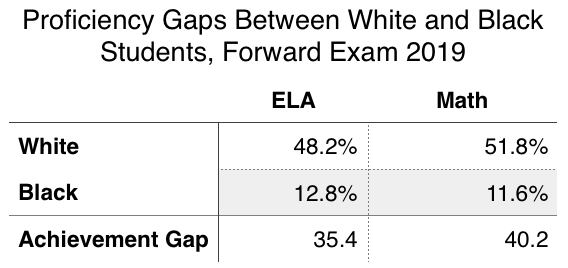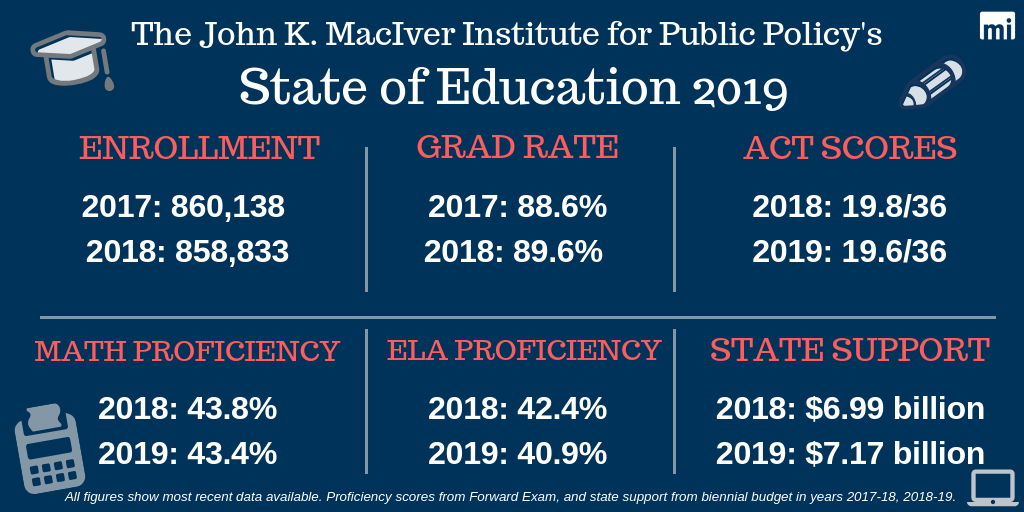
Data Release: Six of Ten Wisconsin Students are Not Proficient in Math or English
School Choice Students Outperform Peers Again
Where is the outrage?
Appalling #WIEducationFail - just 40% of WI students are proficient in English & 43% in math #WIEducationCrisis #OurKidsDeserveBetter #WIEducationFail Click To Tweet
With 6 in 10 students NOT performing at grade level, what does education boss Stanford Taylor have to say about #WIEducationCrisis? Nothing. What about Gov. Evers? Crickets. #OurKidsDeserveBetter #WIEducationFail Click To Tweet
Wisconsin will spend $2.47 billion this year educating students who are not proficient in reading and/or math - @DanODonnellShow #wiright #WIEducationCrisis #OurKidsDeserveBetter #WIEducationFail Click To Tweet
By Ola Lisowski
September 17, 2019
Just four out of ten K-12 students are proficient in math and English language arts, according to new data from Wisconsin’s Department of Public Instruction (DPI). Statewide, only 40.9 percent of all students are proficient or advanced in English language arts, down from 42.4 percent last year. In math, only 43.4 percent of all students show proficiency, a small decrease from last year’s 43.8 percent. According to DPI, a student who rates “proficient” means simply that the student is performing at grade level.
More than one-third of students, 34.4 percent, scored basic on the English languages arts section, while 23.2 percent scored below basic. A larger portion of students received scores of below basic compared to last year, showing a troubling decline in achievement. Millions more dollars have been sent to classrooms in recent budgets, including an increase of more than $655 million in the 2019-21 budget, on top of a $630 million increase in 2017-19. Student enrollment has remained stagnant.
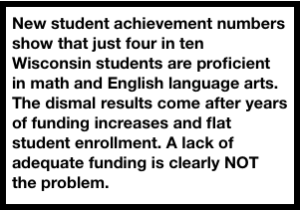
In social studies, 49 percent of students demonstrated proficiency, down from last year’s proficiency of 50.6 percent. Science results were not reported this year because of a change in tested topics.
The results come from the spring 2019 administration of the Forward Exam, which is the fourth time Wisconsin students have taken the test. Nearly 589,000 students in 3rd through 11th grade took the exam. Participation was 98 percent for public school students, and 90.6 percent for private school choice students.
Achievement Gaps Persist
Wisconsin students have long posted some of the widest achievement gaps in the country. The new dataset showed a continuation of the troubling trend, though several gaps shrank slightly.
While 51.8 percent of white students statewide are proficient in math, just 11.6 percent of black students are proficient, totaling a shocking 40.2-point gap. Black students’ math scores improved by a hair, while white students saw a decline in proficiency. Last year’s black-white achievement gap in math was 40.7 points.
In English language arts, a 35.4-point achievement gap exists for white and black students. Just 12.8 percent of black students are proficient in the subject.
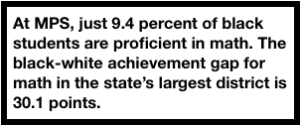
Students in every racial and ethnic group saw small proficiency declines in English language arts. As the state’s non-white population increases, achievement gaps are becoming an increasingly important metric to track and understand.
School Choice Students Outperform Peers
The dataset also included results for the ACT with writing. The results show students in the parental choice programs outperformed their peers on the ACT for the fourth year in a row.
Students in the Wisconsin Parental Choice Program (WPCP), also known as the statewide choice program, scored an average of 20.6 out of 36 points on the ACT with writing, higher than last year’s score of 20.1 points. Wisconsin students statewide scored an average of 19.6 out of 36 points on the ACT, lower than last year’s average of 19.8 points.
Statewide, the average English language arts score was 18.0 out of 36, and the average math score was 19.4 out of 36. WPCP students outscored in those subjects too, with 19.3 points in English language arts, and 19.8 points in math.
Students in the Milwaukee and Racine Parental Choice Programs (MPCP and RPCP, respectively) also outperformed their public school peers. The average composite score for MPCP was 16.8 out of 36, higher than MPS’ average score of 15.5. In the RPCP, students earned an average of 17.6 out of 36 points, higher than Racine Unified School District’s average score of 16.9.
All Wisconsin high school students take the college entry exam at least once. The new results come from one administration of the test to all 11th graders in the spring of 2019.
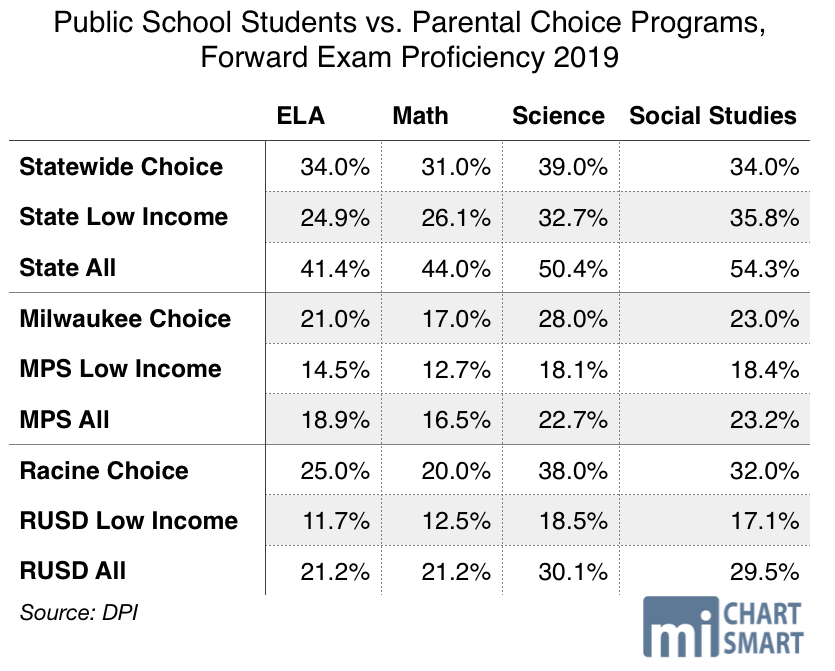
On the Forward Exam, similar results were apparent. Students in Wisconsin’s parental choice programs outperformed low-income peers in similar districts. Choice participants in Milwaukee and Racine outperformed their full-income peers in MPS and Racine Unified School District in almost every subject.
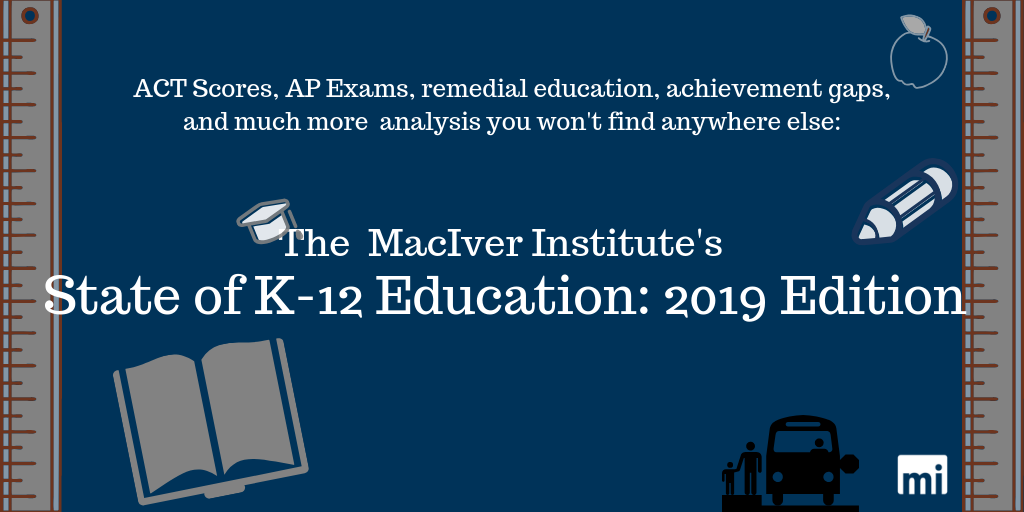
Participation in the state’s parental choice programs is income-limited. New students can only enter the Milwaukee or Racine programs if their families earn less than 300 percent of the federal poverty line, or $75,300 for a family of four. Students outside of those two cities can participate in the statewide program if their family earns less than 220 percent of the federal poverty line, or $55,220 for a family of four.
For that reason, achievement in the choice program is typically compared to economically disadvantaged students in public schools. Not only did school choice students outperform income-limited peers in public schools, but they also outperformed their full-income peers.
A Closer Look at Milwaukee, Madison, Green Bay, Wausau, La Crosse, and Platteville
Milwaukee Public Schools (MPS), the state’s largest school district, had average proficiency far below the state average. Just 16.2 percent of MPS students are proficient in math, the same as last year. 18.6 percent of MPS students are proficient in English language arts, a small decline from last year’s 19.0 percent.
Math achievement gaps widened slightly at MPS. Just 9.4 percent of black students are proficient in math, a slight improvement from last year’s 9.1 percent. This year, 39.5 percent of white MPS students showed math proficiency, totaling a black-white achievement gap of 30.1 points, up from last year’s 29.5-point gap.
Students fared a bit better at English language arts, with 45.3 percent of white MPS students proficient and 10.6 percent of black students proficient for a 34.7-point gap. That’s slightly smaller than last year’s 35.3-point gap.
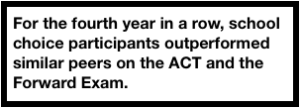
In the state’s capital, English language arts proficiency fell from 36.6 percent to 34.9 percent this year. Madison Metropolitan School District (MMSD) students improved math scores by a hair, moving from 38.2 percent to 38.4 percent proficiency.
With overall achievement among the very lowest in the state, MPS typically receives much more attention for its low scores. But the data show MMSD has an even bigger problem with achievement gaps. In math, the black-white achievement gap in Madison is a shocking 50.2 points. While most ethnic and racial groups slightly improved their math scores over the prior year, the achievement gap still increased by 0.2 points. For English language arts, the black-white achievement gap shrank by several points, from 49.2 to 47.2 points.
Green Bay Area (GBAPS) students improved their math proficiency after two years of stagnation. In that district, 33 percent of students are proficient in the subject, up from last year’s 28.8 percent. However, students did not make similar progress for English language arts. This year, 28.9 percent of students are proficient in English, down from 30.4 percent last year.
In Wausau, student proficiency in English language arts declined for the second year in a row, falling from 47.2 percent proficient to 44.3 percent. In math, scores improved by a hair, moving to 44.8 percent proficient from 44.2 percent.
In the Western part of the state, La Crosse students saw proficiency fall in English language arts, and increase in math. On the most recent Forward Exam, 38.4 percent of students La Crosse showed proficiency in English language arts, continuing a steady decline since 2017, when 41.9 percent of students were proficient. Students fared slightly better in math, with 38.8 percent proficient, up from 2017’s proficiency rate of 36.6 percent.
Platteville students showed the highest achievement among any district highlighted here: 53.1 percent of students are proficient in English language arts, and 60.5 percent are proficient in math. While those scores are better than the state average and other large districts, proficiency rates for both major subjects fell compared to last year, when 56 percent of students were proficient in English language arts and 64 percent in math.
Make sure to check back with MacIver later this week. New State Superintendent of DPI Carolyn Stanford Taylor will give her first State of Education Address at the Capitol on Thursday. Will Stanford Taylor finally say something about these dismal results?
The next big data drop will likely come in November, when DPI is slated to release its annual school and district report cards.
With so many of our children struggling, will any school districts be rated as failing? If 6 in 10 of our children are performing below grade level, how do so many of our schools rate as meeting or exceeding expectations?
